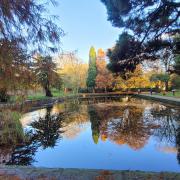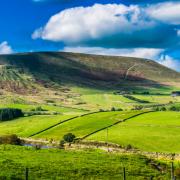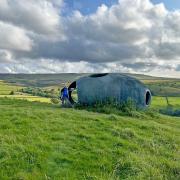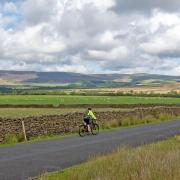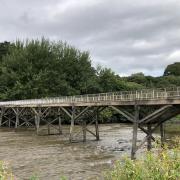Carter leads a walk which follows the Ribble Way though the countryside around Ribchester

Ribchester’s position on the River Ribble was selected by the Romans to protect a ford, then a bridge, their road from Manchester to Hadrian’s Wall crossing at this point.
Their fort was called Bremetannacum and its history is recorded at the small museum in the village, great for students and anyone up in the history of the Roman occupation, less so for the casual visitor. They found a well preserved helmet here but the British Museum bagged it, which is a shame.
The name Ribchester is said to derive from ‘the fort on the Ribble’ but the Romans didn’t call the Ribble that, to them it was the Belisama from which Samlesbury is said to owe its origin. The obvious inference is that Ribble is a corruption of ripple although a ripple was an old agricultural term to describe a method of ploughing. All very confusing.
There is often a settlement wherever there is a bridge from the days when travellers would break their journey at a river crossing. The village which became established to supply the needs of the Roman fort would have continued once they left.

The church is 13th century although records are scanty for the period between then and the Civil Wars when Cromwell came this way leading his army towards Preston notching up another victory for the Roundheads. The village developed from the 18th century with the expansion of hand-loom weaving and it is from this time that many of the tidy cottages date.
For walkers one attraction is the Ribble Way which passes through the village. This long-distance trail starts where the river rises on the fells near the Ribblehead Viaduct and follows the winding course of the river to join the sea at Longton Marsh. The Way was inaugurated in 1985 and I would suggest that since then has not had much maintenance done to it.
The waymarking is inadequate and much of the route requires the use of map and compass. Our walk this month follows it between Ribchester Bridge and Hurst Green partly along the very edge of the river where during the very wet summer of 2012 it was completely covered and impassable.
Park at Marles Wood near Salesbury Hall, now rebuilt and developed into a complex of houses and industrial units. The map shows the course of a Roman road here and I once tried to follow it walking east out of Ribchester. A farmer l shouted that I was trespassing to my indignation, replying that surely if the path was good enough for the Romans it was good enough for me. His reply left me in no doubt as to his opinion of the Romans, walkers and above all, me. I was given two minutes before he set his dog on me.

The fields here were to have been the location for the Royal Lancs Show some years back as a marble commemorative stone records with the optimistic phrase ‘A New Chapter Begins’ below. Sadly the sentiment proved short-lived since the show was rained off and the site abandoned.
Our walk leaves Marles Wood and takes the lane past Salesbury Hall and the ill-fated showground to Ribchester Bridge where the old de Tabley Arms is undergoing renovation and conversion into housing. Cross the bridge and turn right on a private lane that leads past heaps of timber to Dewhurst Farm where you can order supplies of logs for your wood burning stove. On entering the yard, look for a signboard directing Ribble Way walkers to the right via a narrow path leading to the river bank.
Turn left and pick your way along the riverside path, at first through young trees then entering woodland with a lot of fallen branches and flotsam and jetsam and at one point crossing a footbridge over a stream flowing into the river. Stay on this path until a sign indicates you can go no further, directing you over a stile, out of the wood and into a field with a steep bank ahead.
Signing here is insufficient but having climbed the bank don’t stray too much to the right where a line of trees marks the course of the river which we have now left behind us. Once you reach the top of the rising field, look ahead and seek out a gateway with a stile beside it. Here an ancient fingerpost is our only help in keeping to the route and as we go through the next field we pick up another as we climb again to a muddy gateway.
About here you should see the river ahead with the Dinckley Suspension Bridge looking oddly industrial.
Once through the muddy gateway, head to the corner of the next field and go through a hand gate to a lane and cross straight over to a further gate. This field descends gradually to the bottom where a stream has a footbridge across it which we take. Once over the bridge stick to the right hand boundary through two fields then in the third the path exits by way of a short track to emerge opposite the farm buildings of Trough House, a busy working farm through whose yard we pass.
From here the farm track climbs to become Lambing Clough Lane bringing us out at the main road through Hurst Green. There are three pubs in the village from which you can choose, each one welcoming and active and you could even try all three if you decide to bin the walk and get the bus home.
Return down Lambing Clough Lane with fine views of Pendle Hill and after passing through the yard of Trough House again take the narrow path through a plantation of conifers to where the Dinckley Suspension Bridge crosses the river. I am always surprised to find this bridge still standing, fully expecting it to have been carried away by the river in spate but it seems to survive. It certainly wobbles as you cross it but has stood for 60 years so may have plenty of life in it yet.
Cross the bridge and turn right to follow a good well-used path alongside the river to Marles Wood known in times past as Sale Wheel Woods, once the scene of a mass trespass to assert the right of way. Here the river narrows down to funnel through a rocky defile causing whirlpools, hence the word ‘wheel’ or ‘weal’, a spectacular sight after heavy rain. Finally take the steps and climb up to enter the car park by a gate and we are back at the car.
















